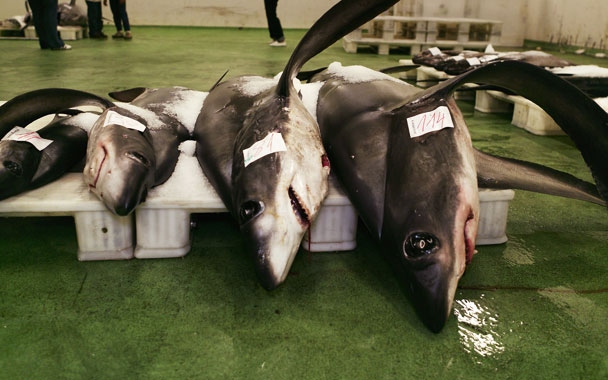Taking the Bite out of the Mediterranean
Is the Med. Sea becoming the new Dead Sea?
It sure looks that way. In a recent study, Francesco Ferretti of Dalhousie University in Nova Scotia reports that shark populations in the body of water risk extinction due to habitat destruction and overfishing. He found that over the past 200 years all of the large shark species he surveyed suffered devastating population declines—losing as much as 99 percent of their numbers.
Sharks, which are under pressure worldwide, join another great marine predator, bluefin tuna, in this grim death march. Earlier this year, Alain Fonteneau of France’s Institut de Recherche pour le Développement, said that Mediterranean bluefin faced “irreversible population collapse.”
It’s a good thing that the region’s cooks create such wonderful dishes from anchovies—unless sensible fishing regulations are enacted, there won’t be anything bigger left in the sea.
The Gang that Couldn’t Shoot Straight
Or, for that matter, do anything else right.
I’m talking about the Food and Drug Administration (FDA)—the outfit charged with keeping 80 percent of the food we eat safe. Last week, while FDA bureaucrats were still bumbling around in a fruitless effort find the source of the tomatoes that had sickened 167 Americans (now that number has climbed to 228) in a nationwide salmonella outbreak, the Government Accountability Office (GAO) issued a scathing report saying that the agency had provided no details about how it is progressing toward implementing the sweeping Food Protection Plan that it proudly unveiled last November. According to The New York Times, the FDA said in March that an update would be available by April. It has yet to be produced. “FDA has added few details on the resources and strategies required to implement the plan,” said the GAO report.
Allow me to translate from the bureaucratese: “They won’t get off their fat butts.”
No surprise there. Since 2004 the GAO has made 34 food-safety recommendations to the FDA. The number actually implemented: seven.
How many other Americans will have to get sick or die before high-level heads start rolling around that place?
An Unpleasant Odor
Who knew? Human excrement is highly flammable.
Canadian food writer and editor Chris Nuttall-Smith drew my attention to an incident earlier this month in which human sewage sludge being stored as fertilizer in a barn spontaneously burst into 50-foot-high flames. A neighbor, who “smelled something awful” in the air before the blaze, alerted the fire department, but the barn was destroyed.
That’s one more reason to be skeptical about fertilizing with the residue of municipal sewage treatment plants—forbidden under United States Department of Agriculture organic standards because of possible contamination by toxic chemicals and who knows what else.
Oh, I neglected to mention the name of the company renting the barn: Fairwind Farms.
An Even More Unpleasant Odor…
…is emanating from the nation’s confined-cow operations. Emissions of hydrogen sulfide, a poisonous gas produced by decomposing manure, became so bad at a 1,500-head dairy farm in Minnesota this week that state health officials advised residents living nearby to evacuate their homes. Measurements showed that levels of the gas in the air were 200 times higher than the legal limit.
Hydrogen sulfide, which has a telltale rotten-egg odor, can cause dizziness, memory loss, respiratory irritation, and even death.
Fortunately, the Environmental Protection Agency’s own scientists agree that pollution from factory farms poses a health risk. So what has the agency proposed to do?
Drop current regulations that require agribusinesses to report emissions of toxic gases.
That way pesky neighbors won’t know what killed them.


